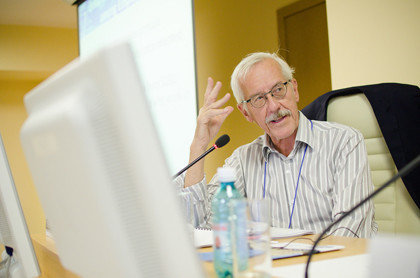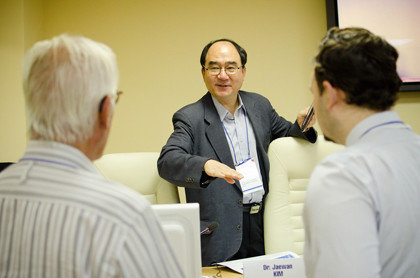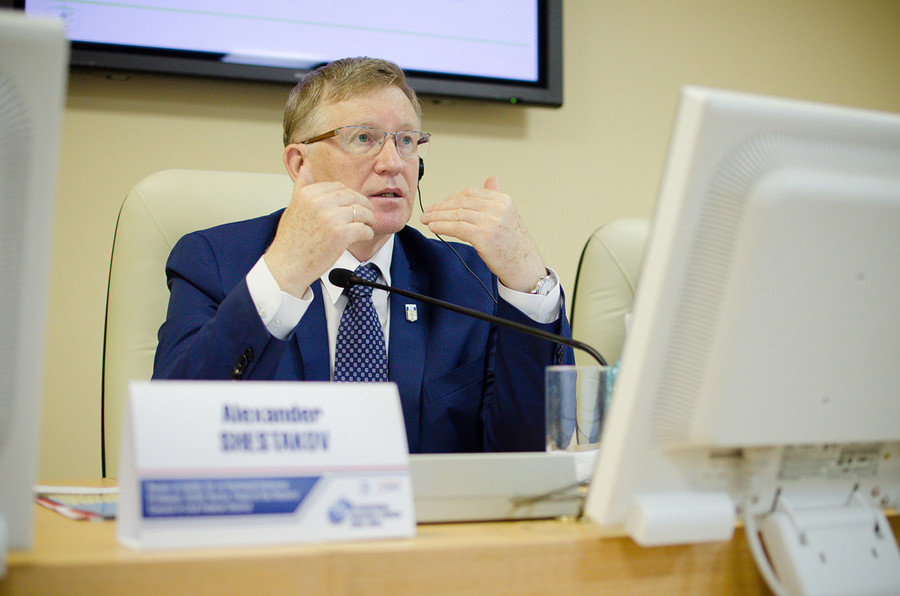
The project on organizing flexible creative groups and attracting the world’s leading scientists to perform advanced research was launched at SUSU as part of the Road Map program under Project 5-100. 5-100. In 2016, under the guidance of prominent international specialists, 8 international research laboratories were established at South Ural State University:
-
Laboratory for Multiscale Modeling of Polyfunctional Compounds
Laboratory Head: Artem Eduardovich Masunov, Ph.D., University of Central Florida, USA. -
Laboratory of Molecular Electronics
Laboratory Head: Wolfgang Haase, Prof., PhD, Darmstadt University of Technology, Germany. -
Laboratory of Migration Studies
Laboratory Head: Jeff Sahadeo, Ph.D., Carleton University, Canada. -
Laboratory for Synthesis and Analysis of Food Ingredients
Laboratory Head: Shirish H. Sonawane, Dr., National Institute of Technology Warangal, India. -
Laboratory of Neurohepatology
Laboratory Head: Julio Licinio, Prof., Flinders University, Australia. -
Laboratory for Mechanics, Laser Processing, and Digital Technology
Laboratory Head: Philippe Bertrand, PhD, National Engineering School of Saint-Étienne, France. -
Laboratory for Self-Monitoring and Self-Validating Sensors and Systems
Laboratory Head: Manus Henry, Dr., University of Oxford, United Kingdom. -
Laboratory for Problem-Oriented Cloud Computing Environments
Laboratory Head: Andrei Tchernykh, Ph.D., Professor, CICESE Research Center, Mexico.
Strategic development of the School of Electrical Engineering and Computer Science is related to development of the “digital duplicates” field of studies. This is a complex project involving tasks related to informational security, automation of technological processes, and analysis of big data.

“The tasks associated with cloud computing perfectly blend in this project,” explains the curator of the Problem-Oriented Cloud Computing Environments, Director of the SUSU School of Electrical Engineering and Computer Science, Gleb Radchenko.“The main goal that we have set for ourselves in the work of the international laboratory is analyzing and designing of methods of managing computational resources in cloud computing environments for the completion of the so-called “digital duplicates”. A digital duplicate is a kind of computational model which is realized as a separate computational service. These models can be of various quality – a finite element computational model, models based on digital processing of big data, static models, and so on. Each of these can use only certain types of computational resources. Our goal is to discover which resources we can provide for each of these models so that cloud computing resources could be used with maximum efficiency in solving various tasks related to designing of digital duplicates.”
The ideas of the “digital duplicates” project are on one plane with the development of the technologies under Industry 4.0. President of the Emerson Corporation Edward Monser on collaboration with SUSU in this field:
“The School of Electrical Engineering and Computer Science studies practically all aspects of Industry 4.0. However, a no less important result of our research is activation of international collaboration: the Head of the Laboratory, Professor Tchernykh, has come to our University twice to deliver lectures, and the SUSU specialists visited the Laboratory at the International Research Center of Ensenada in Mexico. Three scientific articles were released upon the results of our research, and two more articles are being considered to be published in top-ranking international journals. And three more publications might appear before the end of 2017,” says Gleb Radchenko.
.jpg)
The curator and the Head of the Resource Center of Special Metallurgy at SUSU Marina Samodurova on the Laboratory for Mechanics, Laser Processing, and Digital Technology :
“Our international laboratory’s scientific field is the creation of multifunctional and gradient coatings using laser deposition of detonation spraying, and powder metallurgy. In the course of the laboratory’s work, we were able to increase publication activity – 5 articles were published by our scientific group. For students of the Masters’ and Bachelors’ programs new courses have been introduced: “Additive Technologies”, “Pressure Treatment of Non-Ferrous, Powder, and Composite Materials”, “Progressive Technologies of Metal Processing”, and “Special Equipment for Powder Materials Processing”. Through partnerships with major Russian enterprises we were able to realize such joint projects as “Creation of a Flexible Robotic Manufacturing Complex for Laser and Mechanical Processing”, “Elaboration of Laser Alloying (Laser Deposition) Regimes while Creating Large Complex-Shape Part Blanks from Special Alloys Based on Titanium Aluminide” and more.”
The main fields of work of the Laboratory for Multiscale Modeling of Polyfunctional Compounds are computer models, material and substance design, prediction of useful physical and chemical properties of materials, and modeling of structures of yield materials. The curator of the international laboratory Ekaterina Bartashevich:
“We model both molecular structures and single crystals. Modelling molecular structures has been a typical task in science for the past fifty years, unlike modeling of crystal structures. This is a current and more difficult task. This is the challenge we’ve taken on. We see our laboratory as developing simultaneously in two directions. First, in fundamental research. Second, in solving specific, narrow tasks related to the issues of effective structure and characteristics of materials which are topical today for the leading international chemical companies.”


One of the most recent researches of the SUSU Laboratory of Neurohepatology is devoted to the state of the “brain-liver” axis in the context of an experimental syndrome of post-traumatic stress disorder (PTSD), case study of laboratory rats. The studies were completed jointly with the scientific groups of the Center of Genetic Resources of Laboratory Animals SPF-Vivarniy, the Institute of Cytology and Genetics of SO RAS, the Institute of General Pathology and Pathological Physiology, the Institute of Human Morphology, and the Vitebskiy State Medical University:
“First, we developed a new model of PTSD. The model was constructed using multiple replications of signals of danger to rats in the form of predator smells (cat). Unlike other models, this new model reproduces not just behavioral disorders, but also liver lesion, adrenal insufficiency, hypotension, impaired cardiovascular muscle tone, and more. Second, we established that direct behavioral reactions to multiple stress signals are passive-defense and active reactions in a form of the “fight or flight” reaction. A lowered corticosterone level was characteristic for rats with an active behavioral reaction. For rats with a low level of corticosterone, a decreased blood flow in the carotid artery was characteristic, as well as a decrease in the content of N acetyl aspartate in the hippocampus,” says curator of the SUSU International Laboratory of Neurohepatology Vadim Tseylikman, sharing his results.
Under further investigation the laboratory’s researchers came to a conclusion on the reduction of the level of dopamine and serotonin as a result of PTSD with a simultaneous increase in the level of noradrenalin in the hippocampus (the “nosebrain”).
The head of the International Laboratory for Synthesis and Analysis of Food Ingredients Shirish Sonawane on the results of joint work with the SUSU research team headed by Professor of the SUSU School of Medical Biology and the laboratory curator Irina Potoroko:
“The result of our work was a pilot project for creating of fermented milk products rich with biologically-active substances, and of bread with additives from algae, which can become an important discovery in the modern nutrition, prevention, and correction of stress,” Professor notes.
The laboratory is developing methods for synthesizing and modifying food ingredients based on electrophysical effects, and their application in the production of food products to increase the body’s resistance to stressful situations.
.jpg)
SUSU Rector Alexander Shestakov:
“SUSU has the potential to do much more and move much more actively and faster towards the goals set under Project 5-100.”
The international-level laboratories’ research in breakthrough fields of development improves SUSU’s position in the international university rankings and improves the University’s reputation in the international academic community.




